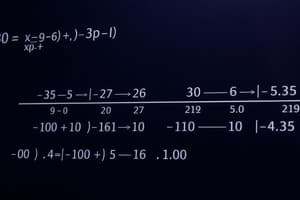Podcast
Questions and Answers
What is the SI base unit for length?
What is the SI base unit for length?
- millimeter
- centimeter
- kilometer
- meter (correct)
Which of the following represents the dimension of force?
Which of the following represents the dimension of force?
- [MLT^-2] (correct)
- [MLT]
- [MLT^2]
- [MLT^-1]
What does the principle of homogeneity state about dimensions in equations?
What does the principle of homogeneity state about dimensions in equations?
- Dimensions can be ignored in mathematical equations.
- Both sides of an equation must have the same dimension. (correct)
- Dimensions have no impact on the correctness of equations.
- All equations are dimensionally correct.
How do you calculate mean absolute error when true value is not known?
How do you calculate mean absolute error when true value is not known?
Which physical quantity is represented by the dimension [ML^2T^-2]?
Which physical quantity is represented by the dimension [ML^2T^-2]?
What is a dimensionless quantity according to the content?
What is a dimensionless quantity according to the content?
What is the formula for relative error?
What is the formula for relative error?
What kind of quantities can have dimensional representation?
What kind of quantities can have dimensional representation?
What is the formula to calculate percentage error?
What is the formula to calculate percentage error?
In the propagation of error when adding two measurements, what is the correct expression for the absolute error in the result?
In the propagation of error when adding two measurements, what is the correct expression for the absolute error in the result?
How is the total reading of a Vernier caliper calculated?
How is the total reading of a Vernier caliper calculated?
What does the least count (LC) of a measuring instrument represent?
What does the least count (LC) of a measuring instrument represent?
In the screw gauge measurement, what indicates that there is no zero error?
In the screw gauge measurement, what indicates that there is no zero error?
What does the formula Δx/x = ± (Δp/p + Δq/q + Δr/r + Δs/s + Δg/g + Δh/h) represent?
What does the formula Δx/x = ± (Δp/p + Δq/q + Δr/r + Δs/s + Δg/g + Δh/h) represent?
Which of the following equations represents the error calculation caused by zero error in a Vernier or screw gauge?
Which of the following equations represents the error calculation caused by zero error in a Vernier or screw gauge?
When taking a reading on a Vernier Caliper, if there is a positive zero error, how is it corrected?
When taking a reading on a Vernier Caliper, if there is a positive zero error, how is it corrected?
Flashcards are hidden until you start studying
Study Notes
Unit and Dimension
- Units: Standard of representing physical quantities.
- CGS system:
- Mass: gram (g) = 1 kg
- Length: centimeter (cm) = 1 m
- Time: second (s)
- MKS system:
- Mass: kilogram (kg) = 103 g
- Length: meter (m) = 102 cm
- Time: second (s)
- CGS system:
- Physical quantity:
- PQ = Numerical value x Unit
- Constant (B) = Numerical value (n) x Unit (y)
- Changing the unit (y) changes the numerical value (n) but the physical quantity (Q) remains constant.
- Dimension: The power of M (mass), L (length), and T (time) needed to represent any physical quantity.
- Velocity: [v] = [MLT-1]
- Acceleration: [a] = [MLT-2]
- Force: [F] = [MLT-2]
- Pressure/Stress: [p] = [ML-1T-2]
- Work/Energy/Torque: [W] = [ML2T-2]
- Power: [P] = [ML2T-3]
- Angular momentum: [L] = [ML2T-1]
- Impulse: [J] = [MLT-1]
- Planck's constant: [h] = [ML2T-1]
- Gravitational constant: [G] = [ML3T-2]
- NOTE: Dimensions of any physical quantity do not depend on the formula used for calculation.
Dimension Rules
- Rule 1: The dimension of a quantity must be consistent with the physical quantity it represents.
- Example: Pressure - x (some quantity) → x must be a kind of pressure.
- Rule 2: Dimension of the Left Hand Side (LHS) must be equal to the Dimension of the Right Hand Side (RHS).
- Principle of Homogeneity: An equation can be dimensionally correct but not mathematically correct.
- If an equation is mathematically correct, it will also be dimensionally correct, with some exceptions.
- Example: Dimensional correctness doesn't guarantee mathematical correctness.
- Principle of Homogeneity: An equation can be dimensionally correct but not mathematically correct.
Other
- Dimensionless Quantities:
- Angle (θ): Dimensionless but has unit (radian).
- Trigonometric functions:
sin θ,cos θare dimensionless. - Logarithmic functions:
log(...)are dimensionless. - Exponential functions:
e(...)are dimensionless.
- Constant Values:
Q = ny = constant- Example:
D<sup>1</sup>/<sub>4</sub>/<sub>1</sub> = D<sup>2</sup>/<sub>4</sub>/<sub>2</sub> - This implies that the product of the numerical value (n) and the unit (y) is constant, even if either n or y changes.
- Example:
- Error Analysis:
- Absolute error: True value - Measured value
- Mean absolute error:
Δa<sub>m</sub> = Δa<sub>1</sub> + Δa<sub>2</sub> + Δa<sub>3</sub> +....n- When the true value is not given, the mean value is used as the true value.
- Relative error:
Δa/a or Δa<sub>m</sub>/a<sub>m</sub> - Percentage error: Relative error * 100.
- Propagation of error in addition/subtraction and multiplication/division:
- Addition/Subtraction:
X = x + x,Y = y + y,Z = X + YorZ = X - YΔZ = ± (ΔX + ΔY)
- Multiplication/Division:
Z = X · YorZ = X / YΔZ = ± (ΔX / X + ΔY / Y)
- Addition/Subtraction:
- Propagation of error in general:
- If any physical quantity (x) is represented as
x = a<sup>p</sup> b<sup>q</sup> c<sup>r</sup> d<sup>s</sup>/<sub>e<sup>g</sup>f<sup>h</sup></sub> Δx/x = ± (Δp/p + &916;q/q + Δr/r + Δs/s + Δg/g + Δh/h)
- If any physical quantity (x) is represented as
Measuring Instruments: Vernier Caliper
- Total reading: Main scale reading (MSR) + Vernier scale reading (VSR) - Zero error
- Main scale reading: Mark on the main scale just before the zero of the Vernier scale.
- Vernier scale reading: Coinciding division of Vernier scale with any main scale mark.
- Least count (LC):
LC = IMSD - IVSDLC = x (1 - IMSD / IVSD)- IMSD = Interval on main scale division
- IVSD = Interval on Vernier scale division
- Zero error:
- No zero error: The zero of the Vernier scale coincides with the zero of the main scale.
- Positive zero error: The zero mark on the Vernier scale is to the right of the zero mark on the main scale.
- Negative zero error: The zero mark on the Vernier scale is to the left of the zero mark on the main scale.
- Zero error calculation:
error = C.V.S.D x L.C.where C.V.S.D is the coinciding vernier scale division.
Measuring Instruments: Screw Gage
- MSR: Main scale reading
- VSR: Vernier scale reading (usually represented as a fraction)
- SD: Number of circular scale divisions
- No zero error: When the zero of the main scale coincides with the "line" and the zero of the circular scale coincides with the reference line of main scale simultaneously.
Studying That Suits You
Use AI to generate personalized quizzes and flashcards to suit your learning preferences.





